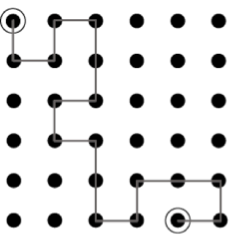The Snake and the Hunter is a game for two players who play in two rounds interchanging the roles of snake and hunter. The game is played in a rectangular grid of points, say $6 \times 6$. In both rounds the snake plays first and begins the game by joining with a straight line any two adjacent (either vertically or horizontally, but not diagonally) points. Thus the snake is born. From then on players take turns to lengthen the snake by one line on either of its extremes. At no stage can the snake “bite” itself. The round finishes when no further lengthening of the snake is possible, at which point the length of the snake, i.e., the number of its lines, is recorded.
In the second round players switch roles and the game proceeds in the same fashion. The winner of the game is whoever achieves the longest snake while playing the role of the snake. (The figure below shows a complete game won by the first player.)
First player's snake of length 25
Second player's snake of length 17
If both players play optimally during a given round, what is the length of the snake obtained?
Note: I originally posted this question in Mathematics Stack Exchange but received no answers.


